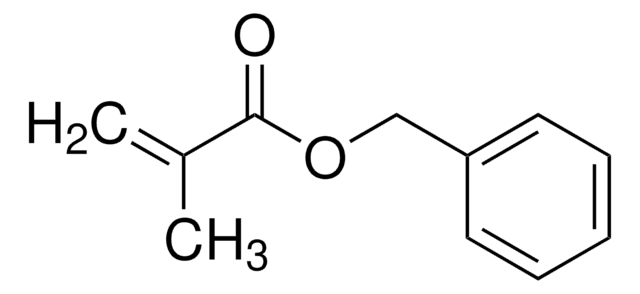327182
tert-Butyl acrylate
contains 10-20 ppm monomethyl ether hydroquinone as inhibitor, 98%
Synonyme(s) :
t-Butyl acrylate
About This Item
Produits recommandés
Pureté
98%
Forme
liquid
Contient
10-20 ppm monomethyl ether hydroquinone as inhibitor
Indice de réfraction
n20/D 1.410 (lit.)
Point d'ébullition
61-63 °C/60 mmHg (lit.)
Densité
0.875 g/mL at 25 °C (lit.)
Chaîne SMILES
CC(C)(C)OC(=O)C=C
InChI
1S/C7H12O2/c1-5-6(8)9-7(2,3)4/h5H,1H2,2-4H3
Clé InChI
ISXSCDLOGDJUNJ-UHFFFAOYSA-N
Vous recherchez des produits similaires ? Visite Guide de comparaison des produits
Description générale
Application
tert-Butyl acrylate can also be used as:
- A building block in the synthesis of asymmetric membranes, which are potentially useful in filtration, separation, or gas permeation processes.
- A monomer in the preparation of a siloxane-incorporated copolymer binder for silicon anodes in lithium-ion batteries.
- A monomer in the synthesis of poly(tert-butyl acrylate)/carbon nanofiber (CNF) materials through atom transfer radical polymerization (ATRP).
Mention d'avertissement
Danger
Mentions de danger
Conseils de prudence
Classification des risques
Acute Tox. 3 Inhalation - Acute Tox. 4 Dermal - Acute Tox. 4 Oral - Aquatic Chronic 2 - Flam. Liq. 2 - Skin Irrit. 2 - Skin Sens. 1 - STOT SE 3
Organes cibles
Respiratory system
Code de la classe de stockage
3 - Flammable liquids
Classe de danger pour l'eau (WGK)
WGK 2
Point d'éclair (°F)
62.6 °F - closed cup
Point d'éclair (°C)
17 °C - closed cup
Équipement de protection individuelle
Eyeshields, Faceshields, Gloves, type ABEK (EN14387) respirator filter
Certificats d'analyse (COA)
Recherchez un Certificats d'analyse (COA) en saisissant le numéro de lot du produit. Les numéros de lot figurent sur l'étiquette du produit après les mots "Lot" ou "Batch".
Déjà en possession de ce produit ?
Retrouvez la documentation relative aux produits que vous avez récemment achetés dans la Bibliothèque de documents.
Les clients ont également consulté
Notre équipe de scientifiques dispose d'une expérience dans tous les secteurs de la recherche, notamment en sciences de la vie, science des matériaux, synthèse chimique, chromatographie, analyse et dans de nombreux autres domaines..
Contacter notre Service technique














![Tris[2-(dimethylamino)ethyl]amine 97%](/deepweb/assets/sigmaaldrich/product/structures/695/792/ee0ff167-22a3-43a7-83a1-6c4908adf0ae/640/ee0ff167-22a3-43a7-83a1-6c4908adf0ae.png)
